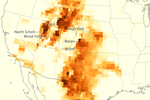
Frozen stream in Minnesota. Photo by: Tiffany Roufs.
Keeping forests standing would lessen both the number and size of spring floods in temperate regions, according to a new study in Water Resources Research, by slowing seasonal snow melts. In deforested areas, snow melts faster due to a lack of shade causing at least twice as many, and potentially up to four times as many, flood events. The new research highlights a largely unknown ecosystem service provided by temperate forests: flood mitigation.
“As soon as you get rid of the trees, the snow melts faster,” explains lead author Kim Green with the University of British Columbia in a press release. “It’s that simple.”
During the annual snow melt, nearby rivers see a sudden infusion of water potentially leading to flood conditions. The rate at which the snow melts is often as important as how much snow melts in total. Because snow melts faster when exposed to full snow (as opposed to under the shade of trees) it’s long been known that deforested areas cause larger floods than forested areas, but the study now adds that deforestation also substantially increases the number of floods.
By analyzing data from three creeks in British Colombia and one creek in Colorado, the scientists found that deforestation pushed 10-year floods (i.e. flood levels that occurred every ten years on average) to happen every three to five years. In addition, 20-year-floods began occurring every 10-12 years, and in one creek in Canada 50-year-flood began occurring every 13 years.
“Once you look at how the frequency has changed,” Green says. “you start to realize that deforestation has had a pretty dramatic effect on floods.”
CITATION: Green, K. C. and Y. Alila (2012), A paradigm shift in understanding and quantifying the effects of forest harvesting on floods in snow environments, Water Resour. Res., 48, W10503, doi:10.1029/2012WR012449.
Related articles
Saving ‘Avatar Grove’: the battle to preserve old-growth forests in British Columbia

(07/23/2012) A picture is worth a thousand words: this common adage comes instantly to mind when viewing T.J. Watt’s unforgettable photos of lost trees. For years, Watt has been photographing the beauty of Vancouver Island’s ancient temperate rainforests, and documenting their loss to clearcut logging. The photographer and environmental activist recently helped co-found the Ancient Forest Alliance (AFA), a group devoted to saving the island’s and British Columbia’s (BC) last old-growth while working with the logging industry to adopt sustainable practices. This February the organization succeeded in saving Avatar Grove—which was only discovered in 2009—from being clearcut. The grove, a rare stand of massive and ancient trees named after the popular eco science-fiction movie, has become a popular tourist destination, providing a new economic incentive for communities to protect rather than cut Canada’s last great forests.
Scientist: ‘no doubt’ that climate change is playing a role in U.S. fires

(07/02/2012) A noted climate scientist says there is ‘no doubt’ that climate change is ‘playing a role’ in this year’s series of record fires in the western U.S. A massive wildfire in Colorado has forced the evacuation of 36,000 people, destroyed over 300 homes, and killed two people. The devastation wrought by the Waldo Canyon Fire even prompted a visit form U.S. President Barack Obama. But this is not the only epic fire in the U.S. this year: less than a month before the Colorado disaster, New Mexico experienced its largest fire on record in Gila Nation Forest; the conflagration burned up 247,000 acres (100,000 hectares). Other major wildfires have occurred in Utah and Wyoming, as well as other parts of New Mexico and Colorado.
Warmer forests expel carbon from soils creating “vicious cycle”

(06/13/2012) As the world warms, temperate forests could become a source of carbon dioxide emission rather than a sink according to a new study in the Proceedings of the National Academy of Sciences (PNAS). Scientists found that two forest sites in the U.S. (Wisconsin and North Carolina) emitted long-stored carbon from their soils when confronted with temperatures 10-20 degrees Fahrenheit (5.5-11.1 degrees Celsius) higher than average.